From cyborg to companion species: readings of fictions by Jeanette Winterson and Karen Joy Fowler
Keywords:
Cyborg, Companion species, Posthuman ontologies, Jeanette Winterson, Karen Joy FowlerAbstract
This paper is centred upon two key figures in Donna Haraway´s critical thought: the cyborg (1985) and the companion species (2003). Coming up in her famous “A Cyborg Manifesto: science, technology, and socialist feminism in the late twentieth century”, and effecting a continuous impact in contemporary debates, the former helped shape a utopian posthuman ontology, thus contributing to the advancement of feminist thought beyond cultural essentialisms and binarisms, in an ironic and critical attitude, aligned with the emphasis on diferences which characterized feminisms in the 1980’s. The limits of her theories on the cyborg are pointed out by Haraway herself, when she justifies her second manifesto, The Companion Species Manifesto – whose ideas are resumed in When Species Meet (2008) – by the perception that the cyborg could no longer, by itself, carry out the feminist task it aimed to. In the readings of the novels The Stone Gods (2007), by Jeanette Winterson, and We Are All Completely Beside Ourselves (2013), by Karen Joy Fowler, I analize fictional figurations of those metaphors, pointing out continuity and rupture lines, with a focus on the question of posthuman ontologies, and exploring the possibilities of strengthening the dialogues between the field of literary studies and the provoking thought of this feminist scholar and activist.
Downloads
References
BALSAMO, Anne. Technologies of the gendered body: reading cyborg women. Durham and London: Duke U.P., 1999.
BECK, Evelyn. Winterson, Jeanette. The stone gods. Library Journal. March 15th, 2008. [resenha]
BLOCH, Ernst. A philosophical view of the detective novel. In: The utopian function of art and literature: selected essays. Tradução Jack Zipes e Frank Mecklenburg. Cambridge, Mass., e Londres: MIT Press, 1995.
_____. The principle of hope. Tradução Neville Plaice, Stephen Plaice e Paul Knight. Cambridge, Mass.: The MIT Press, 1995.
BRANDÃO, I.; CAVALCANTI, I.; COSTA, C.L.; LIMA, A.C. (Orgs.) Traduções da cultura: perspectivas críticas feministas 1970-2010. Florianópolis: Mulheres, Ed Ufsc; Maceió: Edufal, 2017.
CALARCO, Mathew. Boundary issues: human-animal relationships in Karen Joy Fowler´s We are all completely beside ourselves. Modern Fiction Studies, 60, n. 3, 2014.
CAVALCANTI, Ildney. A distopia feminista contemporânea: um mito e uma figura. In: MUZART, Zahidé; BRANDÃO, Izabel (Orgs.). Refazendo nós: ensaios sobre mulher e literatura. Florianópolis: Ed. Mulheres; Santa Cruz do Sul: Edunisc, 2003.
_____. “You’ve been framed”: o corpo da mulher nas distopias feministas. In: BRANDÃO, Izabel (Org.). O Corpo em Revista: olhares interdisciplinares. Maceió: Edufal, 2005.
CAVALCANTI, I.; HARAN, J. O feminismo multiespécies de Donna Haraway. In: BRANDÃO, I.; CAVALCANTI, I.; COSTA, C.L.; LIMA, A.C. (Orgs.) Traduções da cultura: perspectivas críticas feministas 1970-2010. Florianópolis, Maceió: Mulheres/Edufal/EdUfsc, 2017.
_____. O amor em tempos distópicos: corpos utópicos em The stone gods, de Jeanette Winterson. In: CAVALCANTI, Ildney; PRADO, Amanda (orgs.) Mundos gendrados alternativamente: ficção científica, utopia, distopia. Maceió: Edufal, 2011.
_____. The writing of utopia and the feminist critical dystopia: Suzy McKee Charnas´s Holdfast Series. In: BACCOLINI, Raffaella; MOYLAN, Tom (eds.). Dark horizons: science fiction and the dystopian imagination. Nova Iorque e Londres: Routledge, 2003.
GREBOWICZ, M.; MERRICK, Helen. Beyond the cyborg – adventures with Donna Haraway. Nova Iorque: Columbia University Press, 2013.
FOUCAULT, Michel. Os corpos utópicos, as heterotopias. Tradução Selma Muchail. São Paulo: N-1 Edições, 2013.
FOWLER, Karen Joy. We are all completely beside ourselves. Londres: Serpent´s Tail, 2014.
HARAN, Joan. Revisioning feminist futures: literature as social theory. PhD Thesis. University of Warwick, 2003.
HARAWAY, Donna. A game of cat´s cradle: science studies, feminist theory, cultural studies. Configurations (1), 1994. p. 59-71,.
_____. Birth of the kennel: a lecture by Donna Haraway. Aug. 2000. Disponível em: http://www.egs.edu/faculty/donna-haraway/articles/birth-of-the-kennel/ Acesso em: 15 jul. 2014.
_____. Manifestly Haraway. Minneapolis / London: University of Minnesota Press, 2016. 120
_____. Manifesto ciborgue: ciência, tecnologia e feminismo-socialista no final do século XX. Tradução Tomaz Tadeu. In: HARAWAY, D.; KUNZRU, H.; TADEU, T. (Orgs.). Antropologia do ciborgue: as vertigens do pós-humano. Belo Horizonte: Autêntica, 2009.
_____. Otherworldly conversations; terran topics; local terms. In: The Haraway reader. New York: Routledge, 2004.
_____. Simians, cyborgs, and women: the reinvention of nature. London: Free Association Books, 1991.
HARDING, Sandra. The science question in feminism. Ithaca, NY: Cornell University Press, 1986.
_____. Whose science? Whose knowledge? Thinking from women's lives. New York: Cornell University Press, 1991.
KAFKA, Franz. Um médico rural – pequenas narrativas. Tradução Modesto Carone. São Paulo: Companhia das Letras, 1999.
KIRKUP, Gill et al. (Eds.) The gendered cyborg: a reader. London & New York: Routledge, 2000.
OLIVEIRA NETO, Pedro Fortunato. Uma micro-utopia na distopia: a recusa à lógica do canibal em A estrada, de Carmac McCarthy. Trabalho de Conclusão de Curso. Graduação em Letras – Inglês. Universidade Federal de Alagoas, 2016.
SARGENT, Lyman Tower. Do dystopias matter? In: VIEIRA, Fátima (ed.). Dystopia(n) matters – on the page, on screen, on stage. Newcastle upon Tyne: Cambridge Scholars Publishing, 2013.
WINTERSON, Jeanette. The stone gods. London, Penguin, 2008.
WHICH universe are we in? [Em que universo estamos?] (Horizon, BBC 2, 2014).







